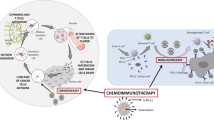Abstract
Target-sensitive (TG-S) liposomes having modified antibodies on their surface were employed to study the release of calcein and the selective delivery of the anticancer agents, doxorubicin (DOX) and methotrexate (MTX). The release of calcein from TG-S liposome occurred when the various target cells were contacted with liposomes and it was proportionally increased with the increase of antibody affinity to the target cells. Increasing the concentration of antigen molecules (major histocompatibility, MHC) on the surface of RMA-S, the release of calcein and drugs from TG-S liposomes contacting with RMA-S also rised. The destabilization of TG-S liposomes was only induced above a threshold density of surface antigen on the target cell membrane. The growth inhibition of specific target cells by the liposomal drugs was always stronger than that of the non-specific ones. For specific target cells, the IC50 of liposomal DOX was about 2 times greater than that of free DOX, on the while, for non-specific target cells, more than 5 times. This indicates that the liposomal drugs were transferred preferentially to the specific target cells than the non-specific ones. Based on this phenomenon, the TG-S liposomal MTX were also applied for the selective elimination of the specific target cells in the mixed culture of specific and non-specific target cells.
Similar content being viewed by others
References
Ahmad, I., Longenecker, M., Samuel, J. and Allen, T. M., “Antibody-targeted Delivery of Doxorubicin Entrapped in Sterically Stabilized Liposomes Can Eradicate Lung Cancer in Mice”,Cancer Res.,53, 1484 (1993).
ATCC Catalog of Cell Lines and Hybridomas 7th ed., 370 (1992).
Chen, W., Khilko, S., Fecondo, J., Margulies, D. H. and McCluskey, J., “Determination Selection of Major Histocompatibility Complex Class 1-Restricted Antigenic Peptides is Explained by Class 1-Peptide Affinity and is Strongly Influenced by Nondominant Anchor Residues”,J. Exp. Med.,180, 1471 (1994).
Heath, T. D., Montgomery, J. A., Piper J. R. and Papahadjopoulos, D., “Antibody-targeted Liposomes: Increase in Specific Toxicity of Methotrexate-γ-aspartate”,Proc. National Acad. Sci., USA,80, 1377 (1983).
Ho, R. J. Y., Rouse, B. T. and Huang, L., “Destabilization of Target-sensitive Immunoliposomes by Antigen Binding-a Rapid Assay for Virus”,Biochem. Biophy. Res. Commun.,138, 931 (1986a).
Ho, R. J. Y., Rouse, B. T. and Huang, L., “Target-sensitive Immunoliposomes; Preparation and Characterization”,Biochemistry,25, 5500 (1986b).
Ho, R. J. Y., Rouse, B. T. and Huang, L., “Target-sensitive Immunoliposomes as an Efficient Drug Carrier for Antiviral Activity”,J. Biol. Chem.,262, 13973 (1987).
Hosken, N. A. and Bevan, M. J., “An Endogeneous Antigenic Peptide Bypass the Class I Antigen Presentation Defect in RMA-S”,J. Exp. Med.,175, 719 (1992).
Huang, L.,“Incorporation of Aclated Antibody into Planar Lipid Multilayers: Characteristics and Cell Binding“,Biochemistry,24, 29 (1985).
Johnstone, A. and Thorpe, R., Immunochemistry in Practice, 253 Blackwell Sci. Pub., Oxford 1982.
Leserman, L. D., Barbet, J., Kourilsky, F. and Weinstein, J. N., “Targeting to Cells of Fluorescent Liposomes Covalently Coupled with Monoclonal Antibody or Protein A”,Nature 288, 602 (1980).
Mosmann, T., “Rapid Colorimetric Assay for Cellular Growth and Survival”,J. Immunol. Method,65, 55 (1983).
Pinnaduwage, P. and Huang, L., “Target-sensitive Liposomes for Potential Therapeutic Applications”, Liposome Technology, Gregoriadis G. ed. 2nd ed. VolIII, CRC Press, London 1993.
Yang, J. M., Yang, J. W., Kim, J. D. and Choe, T. B., “Preparation and Destabilization of Target-sensitive Liposomes”,Kor. J. Biotechnol. Bioeng.,10, 428 (1995).
Author information
Authors and Affiliations
Rights and permissions
About this article
Cite this article
Choe, T., Ku, J., Jung, S. et al. The selective delivery of anticancer agents using target-sensitive liposomes. Korean J. Chem. Eng. 13, 393–398 (1996). https://doi.org/10.1007/BF02705967
Received:
Accepted:
Issue Date:
DOI: https://doi.org/10.1007/BF02705967



